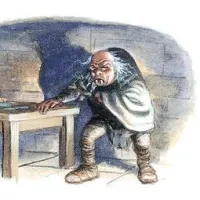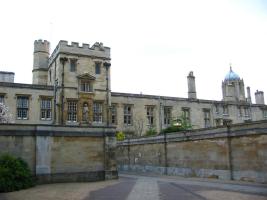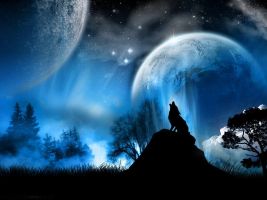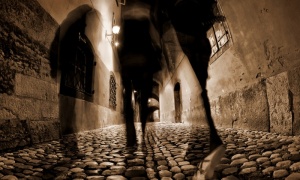For generations the crofters of the Scottish Highlands have passed stories onto their children about the great beasts, or water kelpies, which are supposed to live in the lochs, the best known of which is the Loch Ness Monster. For all the stories about this loch and the mythical beast that is supposed to dwell in its depths, it is sometimes forgotten just how huge this body of water is. Loch Ness is about 38 kilometres long – more than the distance from Dover to Calais – and over two kilometres wide. It is also very deep, 240 metres, which is greater than the average depth of the ocean, and the cliffs around its sides drop sheer to the lake bed. Leaving aside the old wives’ tales, the most common theory about ‘Nessie’ is that it is in fact a prehistoric creature that was somehow ‘trapped’ in the loch. Millions of years ago Loch Ness was an inlet of the sea that became an inland lake when the land rose, trapping a number of sea creatures which were forced to remain and breed there. Today the only outlets to the sea are the shallow River Ness and the Caledonian Ship Canal – both of which are said to be too small for a creature of Nessie’s alleged size.
 The site of Loch Ness is auspicious for a number of reasons quite apart from the storied monster that lurks there. On the shore of the loch stands Castle Urquhart, the scene of several battles between the English King Edward I (called ‘Longshanks’ or ‘The Hammer of the Scots’) and the Scots. Later, Robert the Bruce defended the same castle against an attack by Edward III. It is in the mists of history that we find the tale of the first sighting of the Loch Ness Monster. 1400 years ago Saint Patrick was waiting to cross the loch when he saw some local people burying a dead man who had been bitten by a water monster. The ferocious monster emerged from the loch and came towards the saint, who stood his ground calmly and commanded the beast to go back whence it came. Suitably cowed, Nessie turned tail and fled, seemingly frightened by the saint’s awesome presence and powerful voice.
The site of Loch Ness is auspicious for a number of reasons quite apart from the storied monster that lurks there. On the shore of the loch stands Castle Urquhart, the scene of several battles between the English King Edward I (called ‘Longshanks’ or ‘The Hammer of the Scots’) and the Scots. Later, Robert the Bruce defended the same castle against an attack by Edward III. It is in the mists of history that we find the tale of the first sighting of the Loch Ness Monster. 1400 years ago Saint Patrick was waiting to cross the loch when he saw some local people burying a dead man who had been bitten by a water monster. The ferocious monster emerged from the loch and came towards the saint, who stood his ground calmly and commanded the beast to go back whence it came. Suitably cowed, Nessie turned tail and fled, seemingly frightened by the saint’s awesome presence and powerful voice.
A later monster-hunter was not quite as fortunate as Saint Patrick. In 1527 Duncan Campbell and several other men went to the lochside early one summer morning and were set upon suddenly by the monster, who killed three of them with blows from its tail before returning to the water. Other tales told at the time and later published in the History of Scotland similarly suggest that the monster is of uncertain temperament and to be feared. The modern craze for the Loch Ness Monster started in the 1930s, when there were several rumours in the locality that it had actually left its watery home and was stalking the countryside. This led to a lochside vigil by Sir Edward Mountain and his employees, many of whom allegedly saw the monster and described it, in terms which have become definitive, as having a small head on a long neck, a thick body, flippers and a powerful rounded tail. Such a description gives the strong impression that Nessie may in fact resemble a prehistoric Plesiosaur, a type of carnivorous aquatic reptile which became extinct at the end of the Cretaceous period.
In the 1960s Tim Dinsdale, on his one-man expedition, obtained a film of a large creature swimming in the loch. Several more recent scientific expeditions which have used more sophisticated technology, including boats equipped with echo-sounders, have also concluded that a large and unusual animal lives at the bottom of the loch. The existence of such a large beast is not completely fanciful given that Loch Ness possesses plentiful sources of sustenance, including salmon, trout and migrating eels, all of which come up through the river. Also, it must be said that the Loch Ness Monster is not unique. Loch Morar, Loch Shiel and many other Scottish lakes have strange creatures which are reported to appear in them infrequently. All of these lochs were once inlets of the sea and are located in areas which are now remote. Ireland too has its mythical beasts, including the fearsome Wurrum, which is said to be half-fish, half-dragon. Reports of lake-dwelling monsters which have been handed down from generation to generation have also come from further afield in remote areas of Canada, Iceland and Siberia. There are many who claim that none of these monsters actually exist, especially Nessie, but many more are uncomfortably sure that they do!

















Great article! Interestingly, the most credible modern reports of a Loch Ness monster have involved a creature on land.
Love your writing style!
Thanks 🙂